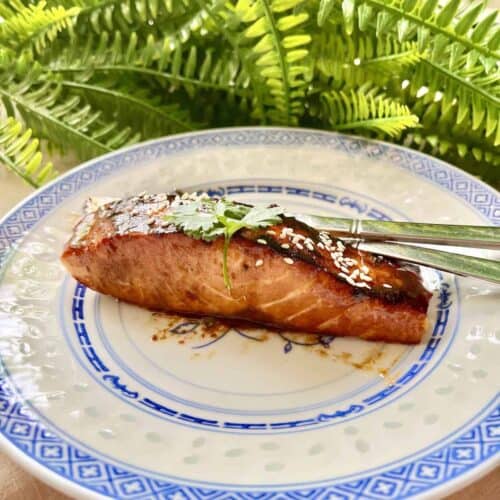Shaoxing vs Sake: similarities, differences, as well as how and when to substitute for each other in Chinese and Japanese cooking.

Shaoxing (shào xīng jiǔ 绍兴酒) and Sake are 2 popular Asian rice wines. There are drinking and cooking grades for both Shaoxing and Sake.
Drinking grade alcoholic beverage is purer and obviously more expensive, but we will only be looking at the cooking wines here. The cooking grades are salted whilst drinking grade is not. (You can get cooking grades of both wines at Asian grocery stores and do not have to go to liquor stores.)
Also known as huā diāo jiǔ 花雕酒, Shao-hsing or Shaohsing wine, Shaoxing rice wine is from the city of Shaoxing (Zhejiang province, China). It's the most common type of Chinese rice wine- you will find it used in soups, congee, chicken stock, chow mein, and famous Chinese dishes such as drunken chicken and lettuce wraps. If you want to recreate what you eat in Chinese restaurants, you'll need to a bottle in your pantry!
Cooking Sake (ryorishu 料理酒) is one of 2 essential Japanese cooking wines (the other is a sweet rice wine, mirin) and it's an essential ingredient in Japanese teriyaki.
Note: Sake, also known as Nihonshu and Seishu, actually refers to all alcoholic drinks in Japan. However, this article is only looking at sake for cooking.
Both wines are used in Chinese and Japanese cooking respectively to:
- like regular wine in western cooking: to add depth of flavor/ umami and improve the taste of food
- remove unappetising smells in seafood and meat dishes
- tenderise meat
To sum up in 1 sentence, Shaoxing is used in authentic Chinese cooking and sake in traditional Japanese food.
Origin, Production & Flavor
Shaoxing

- Made from brown glutinous rice and sometimes aged for 10 years or more, this traditional Chinese cooking wine's longer aging process that gives it a deeper and more complex flavor. Some have a mildly sweet flavor.
- Despite what you may read in other blogs, it is NOT spicy.
- This Chinese wine is not gluten-free as wheat is added to the rice.
- If a Chinese food recipe lists cooking wine, it's almost definitely asking for Shaoxing. (There are other Chinese rice wines, such as Clear Rice Wine/ mǐjiǔ 米酒 and Chinese Rose Wine Mei Kwei Lu.)
Sake

- Sake is brewed from short-grain rice, koji (scientific name: Aspergillus oryzae), yeast, and water.
- Despite calling it a wine, the brewing process is more similar to beer production.
- Most sake is not aged, but there is a very small percentage that is.
- Depending on nuances in the fermentation process and the quality of the ingredients, different types of Sake have different flavors.
- They vary in sweetness, dryness, and clarity. The flavor can be anything from umami and savory to fruity, light and acidic, like dry white wine.
- Some types of sake have a very similar flavor to Shaoxing and can be used as substitutes.
Shaoxing is made from brown glutinous rice whilst sake is made from short grain rice. Generally, sake is not aged whilst Shaoxing is.
Ingredients & Appearance

Both are rice wines. However, Sake has Koji mold added to it.
You can see from the photos above and below that Shaoxing wine is a deeper and darker color- ranging from light brown to dark amber- whilst Sake is a light golden and almost colourless.
It looks very similat to mirin and doesn't change the color of the Japanese cuisine it's added to.
Cooking shaoxing comes in a dark glass bottle whilst cooking sake comes in a clear plastic one. (See below.)

Sake is generally gluten-free whilst Shaoxing is not. (But always check the label.)
Culinary Uses
Shaoxing

Shaoxing rice wine is used in Chinese cuisine dishes such as:
- Stir fry sauces and Stock (chicken broth)
- braised recipes
- marinades e.g. in some salted egg recipes
- stir fries e.g. Kung Pao Chicken
- to remove the fishy flavor from seafood
Sake

Sake is used in Japanese soups, braised dishes and teriyaki:
Where to Buy
Cooking grades Shaoxing and sake are both available from Chinese and Japanese grocery stores respectively, Asian markets, the Asian aisle of a regular supermakret, or online.
Storage

Both wines do not need refrigeration- just store in a cool, dark place.
However, Shaoxing wine has a best before date printed on it that is generally quite long. In contrast, sake is typically kept only for 6 months after opening.
Substitutes

The best substitute for both is a dry sherry, but they are also a good substitute for each other. (If you can't get it, here are other good Shaoxing wine alternatives.)
Any questions about Shaoxing vs sake wines? Let me know in the comments!

















Comments
No Comments